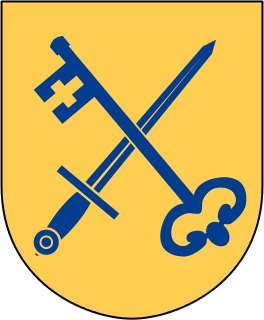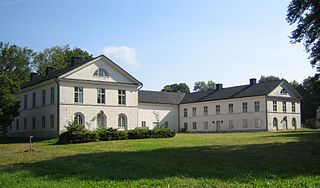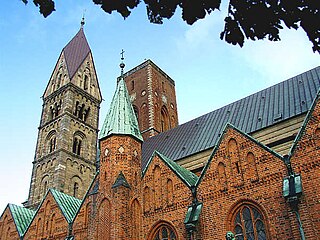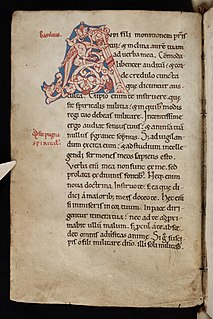
Absalon was a Danish statesman and prelate of the Catholic Church who served as the bishop of Roskilde from 1158 to 1192 and archbishop of Lund from 1178 until his death. He was the foremost politician and church father of Denmark in the second half of the 12th century, and was the closest advisor of King Valdemar I of Denmark. He was a key figure in the Danish policies of territorial expansion in the Baltic Sea, Europeanization in close relationship with the Holy See, and reform in the relation between the Church and the public. He combined the ideals of Gregorian Reform with loyal support of a strong monarchical power.

Lund Cathedral is a cathedral of the Lutheran Church of Sweden in Lund, Scania, Sweden. It is the seat of the Bishop of Lund and the main church of the Diocese of Lund. It was built as the Catholic cathedral of the archiepiscopal see of all the Nordic countries, dedicated to Saint Lawrence. It is one of the oldest stone buildings still in use in Sweden.
Eric II the Memorable was king of Denmark between 1134 and 1137. Eric was an illegitimate son of Eric I of Denmark, who ruled Denmark from 1095 to 1103. Eric the Memorable rebelled against his uncle Niels of Denmark, and was declared king in 1134. He punished his adversaries severely, and rewarded his supporters handsomely. He was killed by a subject in 1137 and was promptly succeeded by his nephew Eric III of Denmark.

Sweyn III Grathe was the King of Denmark between 1146 and 1157, in shifting alliances with Canute V and his own cousin Valdemar I. In 1157, the three agreed a tripartition of Denmark. Sweyn attempted to kill his rivals at the peace banquet, and was subsequently defeated by Valdemar I at the Battle of Grathe Heath and killed.

The Ancient See of Aarhus was a pre-reformation Catholic diocese in Denmark. The diocese included the counties (amter) of Aarhus and Randers, the islands of Samsø and Tunø, and, after 1396, part of the county of Viborg.

The Diocese of Strängnäs is a part of the Lutheran Church of Sweden and has its seat in Strängnäs Cathedral in Strängnäs, south of Lake Mälaren. The diocese is made up of the two provinces Närke and Södermanland.

Herrevad Abbey was a Cistercian monastery near Ljungbyhed in Klippan Municipality, Scania, in the south of present-day Sweden, but formerly in Denmark until 1658. It is now a country house known as Herrevad Castle.

The Bishopric of Ratzeburg, centered on Ratzeburg in Northern Germany, was originally a suffragan to the Archdiocese of Hamburg, which transformed into the Archdiocese of Bremen in 1072.
Eskil was a 12th-century Archbishop of Lund, in Skåne, Denmark.

The former Roman Catholic bishopric of Odense was a diocese in Denmark which included the islands of Funen, Langeland, Tåsinge, Lolland, Falster, Als, and Ærø. Its episcopal see was located in Odense at St. Canute's Cathedral.

The former Diocese of Ribe was a Roman Catholic diocese in Southern Jutland, Denmark. The diocese was established in 948, and dissolved in 1536 during the Protestant Reformation. Within the newly established protestant Church of Denmark, the Diocese of Ribe effectively replaced its Roman Catholic precursor.

The former Diocese of Viborg was a Roman Catholic diocese in Denmark. It was established in 1065 and was dissolved in 1536 during the Protestant Reformation.
All Saints Abbey (Allhelgonaklostret) was a Benedictine monastery at Lund in Scania, Sweden. Located in what was once part of Denmark, it was one of earliest Danish religious houses. There are no remnants of the abbey remaining today.

Dalby Church, sometimes also called the Church of the Holy Cross in Dalby is a church in Dalby, Lund Municipality in the Swedish province of Scania. It is one of the oldest churches in Sweden. When it was built Dalby was part of Denmark, and the church was commissioned by King Sweyn II of Denmark. It was constructed during the second half of the 11th century. For six years, it served as the seat of a bishop, before the diocese was merged with the Diocese of Lund nearby. The church was built with inspiration from Hildesheim Cathedral, and masons from Hildesheim appear to have worked on its construction site.

The Roman-Catholic Diocese of Roskilde was a diocese within the Roman-Catholic Church which was established in Denmark some time before 1022 and lasted until the Lutheran Reformation.

Carl Georg Brunius was a classical scholar, art historian, archaeologist and architect. He served as a professor and rector at Lund University. During 1833-59, he led the restoration work of Lund Cathedral.
Occo of Schleswig was the bishop of the Diocese of Schleswig between 1141 and 1145 and again from 1161 to 1167.

Necrologium Lundense is a 12th-century illuminated manuscript probably made in Lund to serve as a book of rules for the canons of Lund Cathedral, with texts used by them in their daily life. Its oldest parts date from around 1123, and it is considered the oldest still intact manuscript written in Scandinavia. It is preserved in a late medieval binding and the text is partially adorned with decorated initials, including one which displays influences from Viking art. The book is today kept in the University Library of Lund University.

The Danish Civil War were of a series of civil wars fought in the Kingdom of Denmark, first from 1131 to 1134 over the murder of Canute Lavard, and a war of succession fought intermittently between 1146 and 1157, after the abdication of Eric III of Denmark, the only monarch in Danish history to have abdicated. The first phase of the war was fought between King Eric II of Denmark and King Niels joined by Magnus the Strong. The second phase of the war was fought between the son of Eric III, Canute V of Denmark, the son of Eric II of Denmark, Sweyn III of Denmark, and his cousin Valdemar I of Denmark, son of Canute Larvard. The war was the near peak of Holy Roman influence in Denmark, and for a time after, Denmark was a vassal state of Emperor Frederick I. The war ended with the deaths of Niels I, Magnus the Strong, Eric II, Canute V and Sweyn III.















